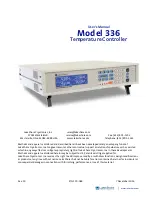
5-66
D60 Line Distance Protection System
GE Multilin
5.2 PRODUCT SETUP
5 SETTINGS
5
work, time error may amount to 1 ms or more. PP is a profile of PTP which specifies a limited subset of PTP suitable for use
in power system protection, control, automation and data communication applications, and thereby facilitates interoperabil-
ity between different vendor’s clocks and switches. PP specifies a worst-case delivered time error of less than 1 µs over a
16-hop network.
In a PTP system and in a PP system, the clocks automatically organize themselves into a master-slave synchronization
hierarchy with the “best” clock available making itself the "grandmaster" at the top of the hierarchy; all others make them-
selves “slaves” and track the grandmaster. Typically the grandmaster clock receives its time from GPS satellites or some
other link to the international time standard. If the grandmaster fails, the next “best” clock available in the domain assumes
the grandmaster role. Should a clock on starting up discover it is “better” that the present grandmaster, it assumes the
grandmaster role and the previous grandmaster reverts to slave.
Time messages issued by the grandmaster are delayed as they pass through the network both due to the finite speed of
the signal in the interconnecting fiber or wire, and due to processing delays in the Ethernet switches. Each clock and switch
implementing PP measures the propagation delay to each of its PP neighbors, and compensates for these delays in the
time received. Each network device implementing PP measures the processing delay it introduces in each time message
and compensates for this delay in the time it transmits. As a result, the time delivered to end-devices such as the UR are
virtually identical to the grandmaster time. Should one of the network devices in the hierarchy not fully implement PP, the
associated propagation delay and/or latency may not be compensated for, and the time received at the end-device could be
in error by more than 100 µs.
See the
Settings > Product Setup > Real Time Clock
section of this manual for a description of when time values
received via PTP are used to update the relay’s real time clock.
The following settings are available for configuring the relay for PTP.
STRICT POWER PROFILE
•
Power profile (IEEE Std C37.238 2011) requires that the relay only select as a grandmaster power profile compliant
clocks, that the delivered time have worst-case error of ±1 µs, and that the peer delay mechanism be implemented.
With the strict power profile setting enabled, the relay will only select as master clocks displaying the IEEE_C37_238
identification codes. It will use a port only when the peer delay mechanism is operational. With the strict power profile
setting disabled, the relay will use clocks without the power profile identification when no power profile clocks are pres-
ent, and will use ports even if the peer delay mechanism is non-operational.
•
This setting applies to all of the relay’s PTP capable ports.
PTP DOMAIN NUMBER
•
This setting should be set to the domain number of the grandmaster-capable clock(s) to be synchronized to. A net-
work may support multiple time distribution domains, each distinguished with a unique domain number. More com-
monly, there is a single domain using the default domain number zero.
•
This setting applies to all of the relay’s PTP capable ports.
PTP VLAN PRIORITY
•
This setting selects the value of the priority field in the 802.1Q VLAN tag in request messages issued by the relay’s
peer delay mechanism. In compliance with PP the default VLAN priority is 4, but it is recommended that in accordance
with PTP it be set to 7.
•
Depending on the characteristics of the device to which the relay is directly linked, VLAN Priority may have no effect.
•
This setting applies to all of the relay’s PTP capable ports.
PTP VLAN ID
•
This setting selects the value of the ID field in the 802.1Q VLAN tag in request messages issued by the relay’s peer
delay mechanism. It is provided in compliance with PP. As these messages have a destination address that indicates
they are not to be bridged, their VLAN ID serves no function, and so may be left at its default value.
•
Depending on the characteristics of the device to which the relay is directly linked, VLAN ID may have no effect.
•
This setting applies to all of the relay’s PTP capable ports.
PORT 1 ... 3 FUNCTION
•
While this port setting is selected to disabled, PTP is disabled on this port. The relay does not generate or listen to
PTP messages on this port.
Содержание D60
Страница 61: ...GE Multilin D60 Line Distance Protection System 2 31 2 PRODUCT DESCRIPTION 2 3 SPECIFICATIONS 2 ...
Страница 62: ...2 32 D60 Line Distance Protection System GE Multilin 2 3 SPECIFICATIONS 2 PRODUCT DESCRIPTION 2 ...
Страница 102: ...3 40 D60 Line Distance Protection System GE Multilin 3 3 DIRECT INPUT AND OUTPUT COMMUNICATIONS 3 HARDWARE 3 ...
Страница 134: ...4 32 D60 Line Distance Protection System GE Multilin 4 3 FACEPLATE INTERFACE 4 HUMAN INTERFACES 4 ...
Страница 508: ...5 374 D60 Line Distance Protection System GE Multilin 5 10 TESTING 5 SETTINGS 5 ...
Страница 538: ...6 30 D60 Line Distance Protection System GE Multilin 6 5 PRODUCT INFORMATION 6 ACTUAL VALUES 6 ...
Страница 610: ...10 8 D60 Line Distance Protection System GE Multilin 10 2 BATTERIES 10 MAINTENANCE 10 ...
Страница 622: ...A 12 D60 Line Distance Protection System GE Multilin A 1 PARAMETER LISTS APPENDIX A A ...
Страница 745: ...GE Multilin D60 Line Distance Protection System B 123 APPENDIX B B 4 MEMORY MAPPING B ...
Страница 746: ...B 124 D60 Line Distance Protection System GE Multilin B 4 MEMORY MAPPING APPENDIX B B ...
Страница 776: ...C 30 D60 Line Distance Protection System GE Multilin C 7 LOGICAL NODES APPENDIX C C ...
Страница 792: ...E 10 D60 Line Distance Protection System GE Multilin E 1 IEC 60870 5 104 PROTOCOL APPENDIX E E ...
Страница 804: ...F 12 D60 Line Distance Protection System GE Multilin F 2 DNP POINT LISTS APPENDIX F F ...
Страница 826: ...xii D60 Line Distance Protection System GE Multilin INDEX ...
















































